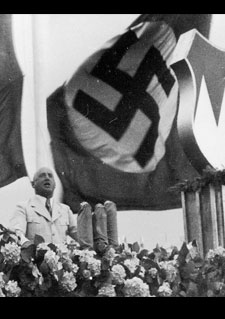Hesselberg: Refusal to Display Flags on Churches
The Hesselberg near Wassertrüdingen had served the Nazis as the setting for large-scale propagandistic rallies every year since 1928. The so-called “Frankentag” was staged by Julius Streicher (1885-1946), Gauleiter of Franconia and publisher of the malicious anti-Semitic tabloid “Der Stürmer”.
In the beginning, the Protestant populace and Franconian church leaders still enthusiastically participated in the worship of the racial national community on the Hesselberg (T. Greif, Flaggenstreit, 171). This changed, however, when Hermann Göring (1893-1946) delivered an anti-church speech at the “Frankentag” in June of 1935, which even attracted notice abroad.
With an eye toward the church, Göring proclaimed: When we make a pilgrimage to one of our ancestors’ ancient places of worship, they may call that paganism; but they may not blame us when we congregate here again in the unity of our nation to lift up our hearts to our Führer’s idea, instead of listening to the prattling of quarrelsome clerics. It is better that we bear witness to the unity of our nation, than that we let this nation be driven apart by denominational squabbling. (J. Gauger, Chronik 3, 526).
This speech not only provoked protest from Regional Bishop Hans Meiser (1881-1956), clergy associations and parishes but also prompted a dispute with the party and the state over the display of flags on church buildings.
From the pulpits was heard that still displaying the flag on churches and parsonages on this occasion would be characterless after the anti-church invectives at the “Frankentag”. In a letter of May 27, 1937 to the regional consistory, the pastor in Hilpoltstein asserted that displaying the flag was a sheer impossibility. The church would thus be slapping itself in the face! (T. Greif, Flaggenstreit, 173).
Since the Bavarian church government only issued contradictory instructions, the decision to display the flag was left up to the parishes themselves. As local police stations observed during the 1937 “Frankentag”, the majority of parishes decided not to display the flag on their churches.
In the Nazis’ eyes, this refusal was an indication that the clergy rejected National Socialism. District authorities received instructions to bring criminal charges against the pastors responsible.
Nevertheless, the parishes abandoned their resistance against displaying the flag when the church government’s negotiations with state and party authorities to exempt the churches from the order to display the flag with broke down in advance of the 1938 “Frankentag”. Just one letter of protest from Regional Bishop Meiser followed once again because Julius Streicher had continued his anti-church attacks at the “Frankentag”.
After the end of World War II, the Bavarian church government symbolically selected the Hesselberg as the site of the first Protestant regional community college.
Source / title
- © Dokumentationszentrum Reichsparteitagsgelände, Nürnberg

